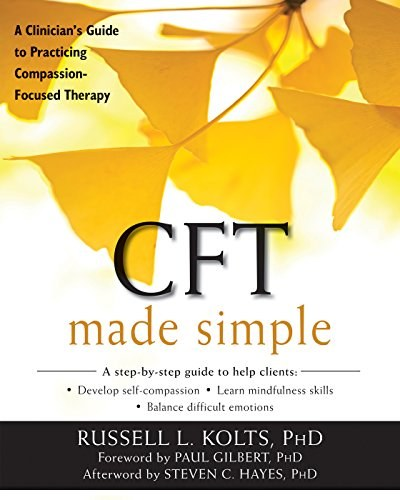封面
CFT Made Simple: A Clinician’s Guide to Practicing Compassion-Focused Therapy by: Russell L. Kolts
CFT Made Simple: A Clinician’s Guide to Practicing Compassion-Focused Therapy
内容简介 · · · · · · Created by world-renowned psychologist Paul Gilbert, compassion-focused therapy (CFT) is extremely effective in helping clients work through painful feelings of shame and self-criticism. However, the theoretical aspects of this therapy-such as evolutionary psychology, attachment theory, and affective neuroscience-can make CFT difficult to grasp. This book provides everything you need to start implementing CFT in practice, either as a primary therapy modality or as an adjunctive approach to other therapies, such as acceptance and commitment therapy (ACT), cognitive behavioral therapy (CBT), and more.CFT has unique strengths, and is especially effective in helping clients work through troubling thoughts and behaviors, approach themselves and others with greater compassion and kindness, and feel safer and more confident in their ability to handle life's challenges and difficulties. This book articulates the theoretical basis of the therapy in simple, easy-to-follow language, and offers practical guidance and strategies on how to tailor your CFT approach to specific client populations.As a clinician interested in the benefits of CFT but wary of the dense theoretical principles that lay behind it, you need a user-friendly guide that will let you hit the ground running. CFT Made Simple is that guide.
CFT Made Simple: A Clinician’s Guide to Practicing Compassion-Focused Therapy (The New Harbinger Made Simple Series)
For the first time ever, CFT Made Simple offers easy-to-apply tools to help clients develop self-compassion, learn mindfulness skills, and balance difficult emotions for greater treatment outcomes.
Created by world-renowned psychologist Paul Gilbert, compassion-focused therapy (CFT) is extremely effective in helping clients work through painful feelings of shame and self-criticism. However, the theoretical aspects of this therapy—such as evolutionary psychology, attachment theory, and affective neuroscience—can make CFT difficult to grasp. This book provides everything you need to start implementing CFT in practice, either as a primary therapy modality or as an adjunctive approach to other therapies, such as acceptance and commitment therapy (ACT), cognitive behavioral therapy (CBT), and more.
CFT has unique strengths, and is especially effective in helping clients work through troubling thoughts and behaviors, approach themselves and others with greater compassion and kindness, and feel safer and more confident in their ability to handle life’s challenges and difficulties. This book articulates the theoretical basis of the therapy in simple, easy-to-follow language, and offers practical guidance and strategies on how to tailor your CFT approach to specific client populations.
As a clinician interested in the benefits of CFT but wary of the dense theoretical principles that lay behind it, you need a user-friendly guide that will let you hit the ground running. CFT Made Simple is that guide.
CFT Made Simple: A Clinician’s Guide to Practicing Compassion-Focused Therapy》是一本旨在为临床医生提供如何实践慈悲聚焦疗法(CFT)的指导书籍。以下是该书的主要内容摘要:
引言
- 定义与操作化:本书介绍了慈悲的定义,并探讨了CFT如何将慈悲具体化为帮助客户培养的属性和特定技能。
- 治疗层次:CFT采取分层治疗方法,包括治疗关系、发展慈悲理解、培养正念意识,以及具体发展和应用慈悲。
第一章:起源与核心主题
- 起源:探讨了CFT的起源及其核心主题。
-
核心主题:
- 去羞耻化和去病理化客户的体验。
- 模范慈悲和面对痛苦的勇气。
- 促进从评判到理解的转变。
- 促进安全体验的形成。
第二章:介绍慈悲
- 深入慈悲:进一步探讨慈悲的概念及其在治疗中的具体体现。
第十五章:结论
- 慈悲的力量:慈悲使我们能够以善意、智慧和勇气面对令我们害怕的事情。当我们不再试图避免不适时,可以转向痛苦并深入探究其原因和条件,从而更好地理解和改善情况。
尾声:拆解慈悲之心
- 连接性:本书是慈悲聚焦疗法的入门指南,强调了自我慈悲、对他人的慈悲、正念和基于价值观的行为等新方法之间的相互联系。
- 勇气为中心:尽管慈悲涉及自我善良,但其核心在于勇气。作者Russell Kolts通过在监狱中处理愤怒问题的经验,开发了名为“True Strength”的CFT方法,强调慈悲是转向自己和他人痛苦的勇气。
序言
- 主题概述:Russell Kolts利用自己的经验概述了CFT的关键主题,指出慈悲的核心是勇气,即转向自己和他人痛苦的勇气。
这本书不仅提供了理论基础,还提供了实际操作的指导,旨在帮助临床医生有效地运用CFT来改善客户的心理健康。
- 致敬导师Paul Gilbert
目录
-
引言
- 介绍本书的目的和结构
-
第一章:起源与基本主题
- CFT的起源
- 核心主题
- 去羞耻化和去病理化客户的体验
- 模范慈悲和面对痛苦的勇气
- 促进从评判到理解的转变
- 促进安全体验的形成
-
第二章:介绍慈悲
- 深入理解慈悲
- 慈悲在治疗中的具体体现
-
第三章:慈悲关系:治疗师在CFT中的角色
- 治疗师的角色
- 建立治疗关系的重要性
-
第四章:慈悲理解:进化如何塑造我们的大脑
- 大脑的进化
- 慈悲与大脑的关系
-
第五章:慈悲理解:三种情绪类型
- 情绪的分类
- 不同情绪类型的处理方法
-
第六章:慈悲理解:社会对自我的塑造
- 社会因素对自我认知的影响
- 如何在治疗中考虑这些因素
-
第七章:慈悲意识:培养正念
- 正念的概念
- 如何在日常生活中培养正念
-
第八章:承诺慈悲:处理自我批评
- 自我批评的原因和影响
- 如何用慈悲替代自我批评
-
第九章:培养慈悲自我
* 慈悲自我的概念
* 如何培养慈悲自我
- 第十章:慈悲思维与推理
* 慈悲思维的特点
* 如何进行慈悲推理
- 第十一章:使用慈悲意象
* 慈悲意象的作用
* 如何在治疗中使用慈悲意象
- 第十二章:体现慈悲:CFT中的椅子工作
* 椅子工作的概念
* 椅子工作的具体操作步骤
- 第十三章:慈悲整合:CFT中的案例概念化
* 案例概念化的意义
* 案例概念化的具体步骤
* 组件描述
* 内在和历史影响
* 关键恐惧的探索
* 自我和他人的互动模式
* 安全策略的识别
* 治疗计划的制定
* 非预期后果的探索
- 第十四章:探索情感:多重自我练习
* 多重自我练习的概念
* 如何进行多重自我练习
- 第十五章:乘风破浪:将CFT融入您的治疗
* 如何将CFT与其他治疗方法结合
* CFT在不同治疗场景中的应用
结论
- 总结CFT的核心理念和实际应用
后记:拆解慈悲之心
- 慈悲的本质
- 慈悲与勇气的关系
致谢
- 感谢导师和同行的支持
附录:可复制的表格
- 提供实用工具和表格,方便读者在实践中使用


